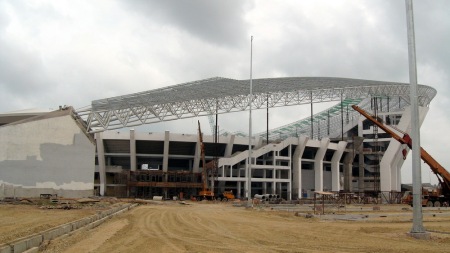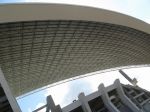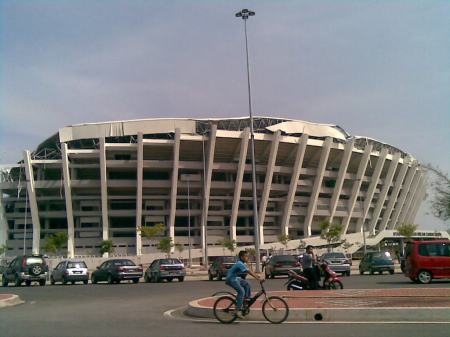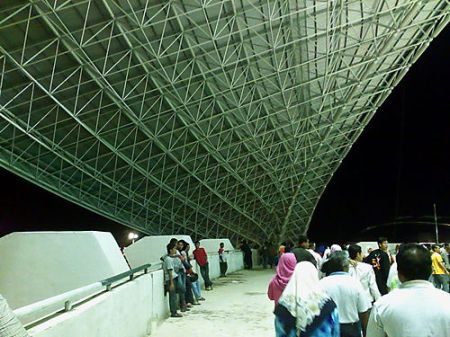What were the most probable causes of this stadium to collapse? From these pictures and some basic structural engineering and mechanic of materials knowledge the engineer should be able to disgnose some probable causes that may cause the collapse. Please make your observation , apply the knowledge and make your diagnosis. It is also necessary to interview peoples on site during the collapse to know the sequence of events before collapse and to confirm our diagnosis.
The roof was made up of space trusses. It was a skeletal latticed shells.
American Society of Civil Engineers(ASCE) defined a latticed structure is a structure in the form of a network of elements(as opposed to a continous surface). Rolled , extruded or fabricated sections comprise the member elements. Another characteristics of latticed structural system is that their load-carrying mechanism is three dimensional in nature.
The general behaviour of this thin, very long span structure may be explained easily and understood by the behaviour of thin shell , latticed shells and braced domes structure .
Member Behaviour
A compressive structural member buckles after reaching its critical stress and enters into post-buckling. The load carrying capacity of a buckled member is substantially less than that of a pre-buckled member. Under a constant applied load environment, the buckling of a member usually leads to inelastic post-buckling.The post-buckling behaviour of a truss member is greatly dominated by the selender ratio. A failure of a member in a redundant truss system may potentially result in the stress reversal in other members. Stress reversal in a buckled member is difficult to model exactly, and not much experimental data are available.
A collapse mechanism results from the redistribution of load when one member fails, causing a subsequent progressive overstress condition in other members. Initial lack of fit may cause prestressing in members, with subsequent unexpected failure at relatively low loads. Where member sizes are varied to allow as many members as possible to be fully stresses under worst case loading(optimised design), progressive collapse may not be possible. In this case, several members may fail simultaneously, thereby causing an apparent brittle(sudden) failure os the structure.
In practice, space truss structures have a high number of redundant members, but this does not necessarily confer a corresponding high factor of safety on the structure because the path to collapse may pass through through a small number of members. Collapse of such structures is not uncommon and can have dire safety and economic consequences. Analyses based on the static load redistribution condition of space trusses have shown that the loss of only one critical member can lead to total collapse of the structure at full service loadings.
Two practical methods for analyzing space trusses for progressive collapse include a) the member removal methods and b) the member residual strength method. Both methods essentially follow the same procedure as outlined below:
(1) Analyze the structure(using linear elastic procedures) to determine which member will fail first( i.e which member has the highest stress compared to the design capacity.)
(2) Depending on the method being used, either a) completely remove the member that has reached its maximum capacity and will fail due to overstress(member removal method) or b) limit the load capacity of the member after it reaches its maximum capacity(member residual strength method).
(3) Reanalyze the structure with the removed(zero strength) or reduced strength member, and identify the next member most likely to fail.
(4) Return to the second step and iterate until the structure’s capacity is signigicantly reduced(i.e , the structure is about to collapse or can no longer carry the design load.)
When applying the Member Residual Strength Method, the designer must decide what constitutes the residual strength of a member. For major structures, it is recommended that full scale member tests be performed, in tension and compression, to estimate the post-maximum load behaviour of the space truss members.
Dynamic Effects of member failure
In a truss-type structural system, when members are primarily carrying axial loads, member failure may take place by yielding(tension) or buckling of compression members. Besides due to external dynamic forces, a structural vibration, a tesion-yielded member may take up additional load due to strain hardening, whereas compressive buckled members lose strength and shed load to other members. The critical stress beyond which a member buckles is normally far less than yield stress.Therefore, a greater emphasis must be given for member failure under compression. Two major types of sudden member failure which have potential to cause dynamic effects in structure are:
(1) Brittle-type member failure. This type of failure may take place within the linear ealstic regime. When a member fails in this fashion, it is assumed that the member after failure does not have any load-carrying capacity. For material other than brittle, this type of failure can arise due to reasons such as material defects, fabrication or construction errors, impact and accident..
(2) Member failures due to buckling and post buckling. A compressive structural member, after its initial elastic buckling may enter into inelastic post-buckling. Depending upon the selenderness ratio and other factors, this process may be accompanied by sudden loss in load-carrying capacity of the member, thus giving rise to member snap/dynamic jump(a dynamic phenomenon)
Aerial View of the stadium
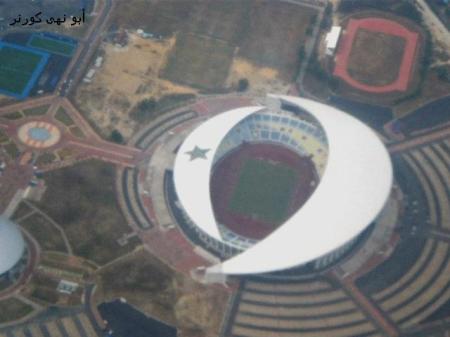
Pic 1
This lattice shell structure is very sensitive to movement of the supports.Any movement of the supports will cause redistribution of forces within the whole structure. Can the two concrete buttresses at both ends of the collpase roof and all the perimeter columns provide the required rigidity? Proof ?
Stadium before collapse
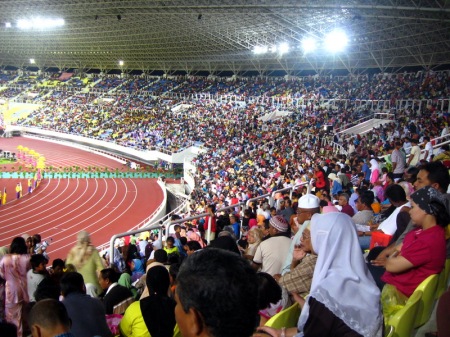
Pic 2
Imagine if the collapse happened at this moment. Thousands of people will be killed and injured!
Stadium after collapse
Please look these pictures for clues. It showed some tell tale sign that need to be confirmed by measurements, analysis and testing
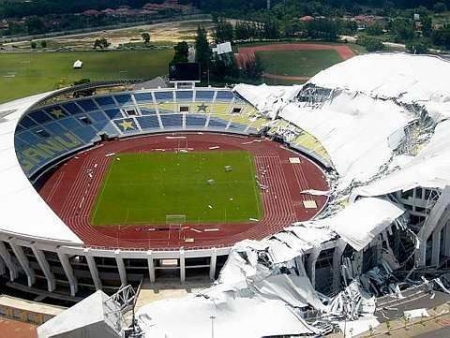
Pic 3 What were the sequence of failures before total collapse?
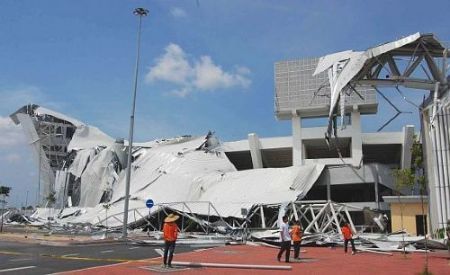
Pic 4 Observed the remaining space trusses attached to the concrete buttress
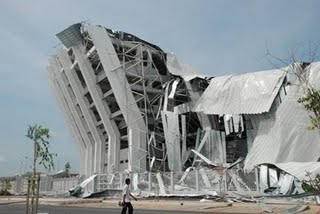
Pic 5
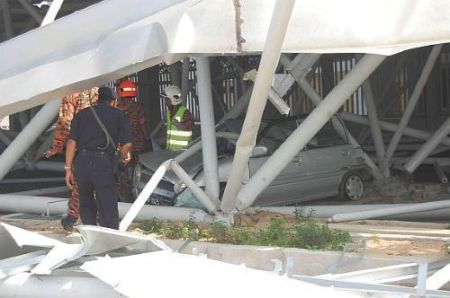
Pic 6

Pic 7 . The other concrete buttress. Observed similar pattern of failure
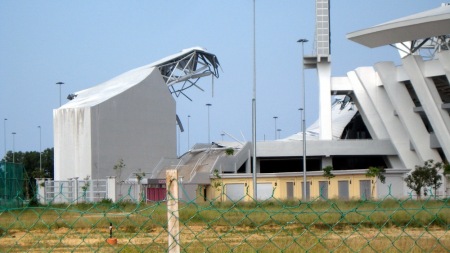
Pic 8 Concrete Buttress

Pic 9 See the large span between the concrete butress and the first column support along the perimater

Pic 10
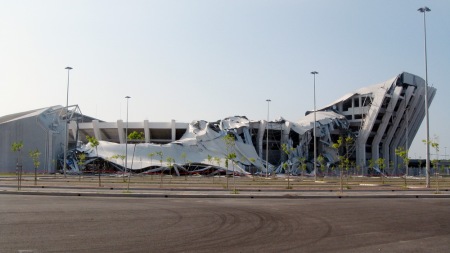
Pic 11

Pic 12
What were the possible forces acting on assemblage in the zone where the space truss snapped? These forces originated from :Vertcally- Dead Load, Rain water loading!In plane loading due to temperature effect, Horizontally(reversable)-wind loading and other dynamic loading such as ground movement!
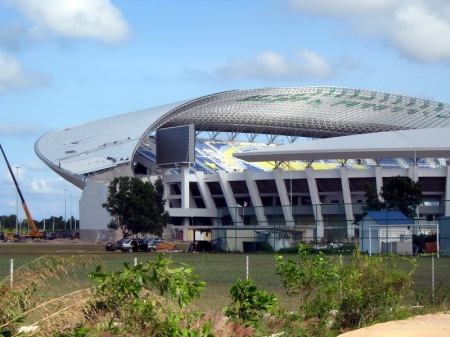
What were the “Demand” of all possible worst forces at the end of space trusses near the concrete butresses? What were the “Capacities” of the steel members, connections and assemblage against those forces?
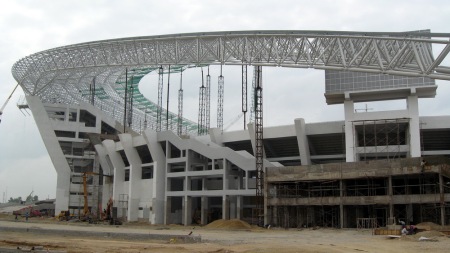
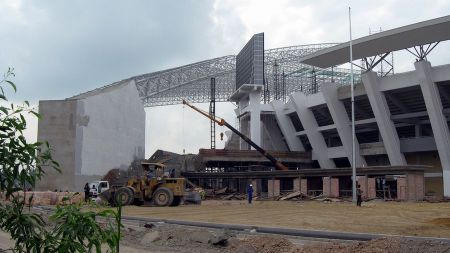
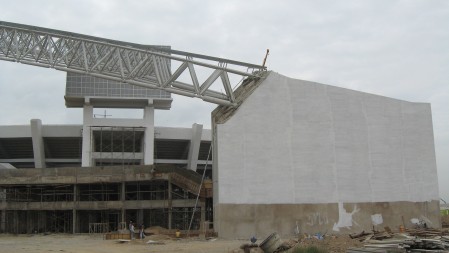
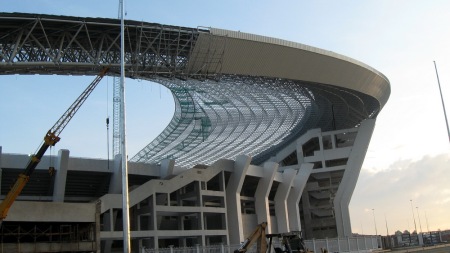
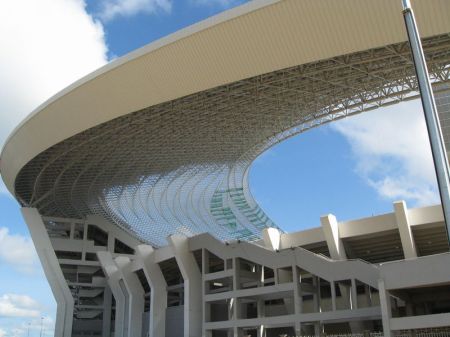
Pic16a Click on the caption to enlarge the pic.
This photo showed the space frames were supported by connection at the column butress and the columns along the perimeter of the stadium. This column free portion on both side of the stadium looks unstable. The space frame was mainly supported by the columns placed along the perimeter of the stadium.(See photo 18,12,20 and 22.
Question:
What was the adequacy of these columns to support the worst loading from the space frame? Observe the size of the last perimeter steel column assemblage?
What was the adequacy of these columns to support the worst loading from the space frame? Observe the size of the last perimeter steel column assemblage?

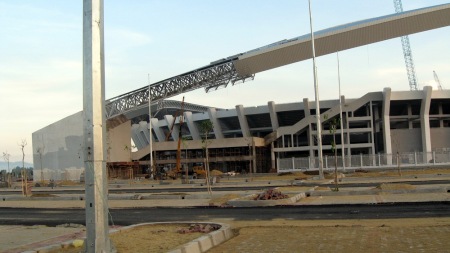
Pic 19

Pic 20 The space truss were supported by steel columns along its perimeter and the two concrete buttresses at the tips.
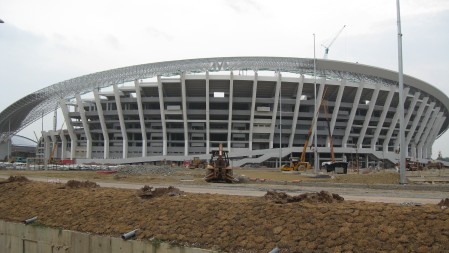
Pic20a View during construction
Notice all column bases were dislodged at the its connection to the concrete stump. Need to observe the mode of failure of the base plate. It may be failure of the welds,shearing of bolts, prying of the plate due to inadequate thickness or snapping of hold down bolt in tension or any of their combination. I am sorry I dont have the photos of this column to concrete stump connections

Pic 22
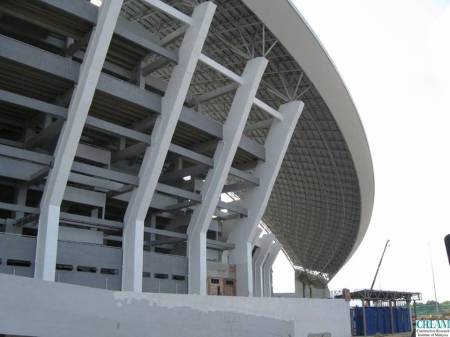
This photo showed the inclined, curved space frame was supported only at two points i.e at the last perimeter columns and the concrete stump(see pic 12). The photos showed the column free span was very large maybe greater than 30 m.
The above configuration may create large torsional forces at the column stump supports. (compare pic 1 with pic 28).
What was the worst torque at the ends of the space trusses where it snapped?(see pic 7 & 8). What was the torsional capacities of the space trusses at that section?
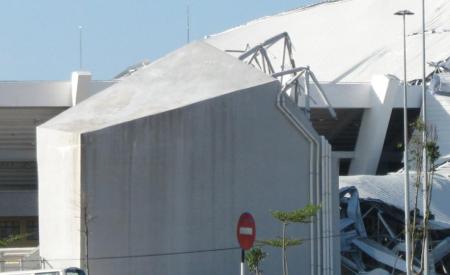
Pic 24a
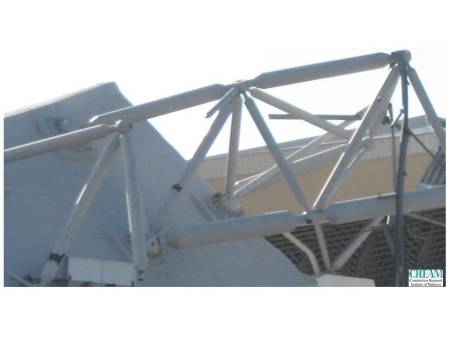

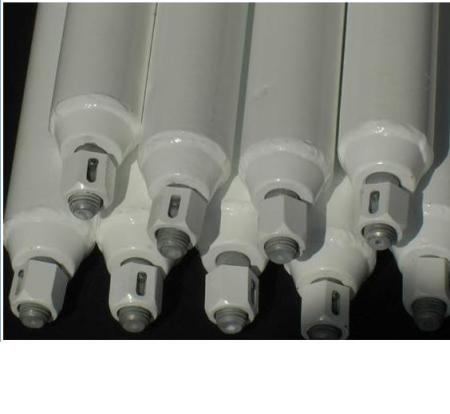
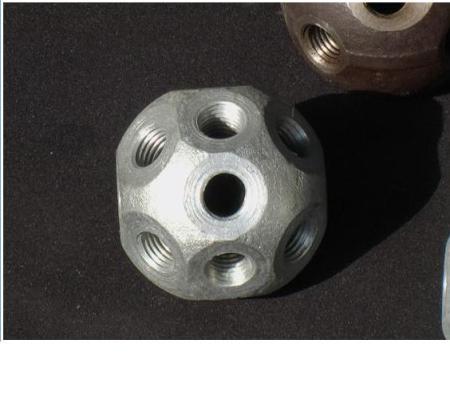
HERE to see a more detail view of Pic 24b and what evidences can you get on the failure of this zone to help you in the failure investigation of this space trusses?
HERE to see a more detail view of Pic 21 and evidences on the perimeter columns after collapse
Here are the evidences from Pic 24b.Similarly evidences can be identified, categorised from other components of the structures.
From this pic it was observed ;
1. Buckling of inclined members(tube){Sign of load exceeding Buckling capacities}
2. Pullout of the threaded screws from the ball joints{Sign of very high tensile load in the tubular members exceeding its tensile capacities}
Why the two tubular members buckled and the other members threaded bolts were pullout of the steel ball joints?
This photo extracted from Pic23 shows Why the two inclined tubular members buckled and the other members threaded bolts were pullout of the steel ball joints.
The truss (self weight and any live load) P at an eccentricity e , any horizontal load resulted from wind pressure, the dominating effect of geometry and the ends restrains created large torsional forces at the supports. These forces must be resisted by the inclined and diagonal tubular members which were either in tension or compression. These forces exceeded the axial compressive and tensile capacities of the tubular members creating the observed phenomena.
It is believed the buckling of the tubular compression strut triggered the progressive collapse of the whole roof. A detailed structural analysis as stated in the Member Behaviour will proof this diagnosis.
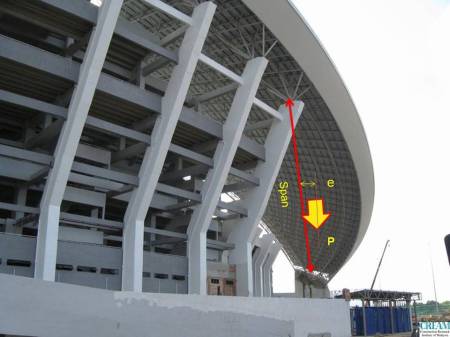
3. ruptured of the members(tubes) and the nodes. {Sign of very high tensile load in the tubular members and the steel ball joints exceeding its tensile capacities}
a) Analyse the structure and determine the maximum axial forces in members. Confirm these members behave as intended i.e compression or tension. Thsese forces are the demand. (Note: In the vicinity of the cantilever around the perimeter columns the top boom will be in tension and the bottom boom will be in compression. The inclined diagonals may be in tension or compression. Similarly for members at the concrete butress supports.)
b) Determine the axial capacities(compression or tension) of these members.
c) Determine the factor of safety i.e ratio of capacities/Demand for the critical members.The member with lowest factor of safety will probably collapse first.
Do the 4 steps analysis as stated in Member Behaviour for progressive collapse .
Based on the observation, evidences,results of analysis and diagnosis it is then we do the elimination processes to zoom in the most probable cause of the collapse. It may be due a combination of causes.
Testing
We start by doing some actual 1) components and 2) representative samples tests cut from the collapse space truss components.
The representative sample tests will yield basic properties of the materials(steel tubes) such as the Yield Stress and Yield strain, % elongation, rupture stress and strain and so on.
These basic properties should be used to estimate the component compressive or tensile strength of the members.
Next we do the component test to determine and confirm the capacities of the tubular members especially in compression, tensile capacities of the threaded bolts and tensile and compressive capacities of the steel ball joints, and compression capacities of the sleeves and the end cones(see typical node above). See pg. 90 of ref. 10 for Load tests on space truss connections.
Probable Causes
Compare the results of Strucutral Analysis with what observed on site or evidences obtained from site. If the results dosnt telly with what observed on site, your analysis was wrong. Revised your structural analysis.
Compare the materials properties results obtained from tests with the what were in the drawings and specification.
Determine what does not comply with the specified Code of practices, drawings and specification.
In most cases, at the Diagnosis Stage, simple hand calculation will do (without using computer softwares etc). Softwares are only used to check and confirmed the diagnosis. The FUNDAMENTALS are the most important in the failures investigation . Understanding the fundamentals will guide us to answer a lot of key questions e.g What, Where, Why ,How the failure happened? It will help us on what to focus during the investigation and saving time on unncessary processes e.g there is no necessity to test the concrete strength of the buttresses or column stumps as the pictures showed all the steel ball connected to the conrete components were intact. We can eliminate the strength of the concrete in the investigation even by looking at the pictures. So the focus should be on the steel space frame and its components. Decisions on what type of analysis, type of tests, location of samples to be tested and frequency of sampling, selection of components to be tested shall be decided during the desk study .
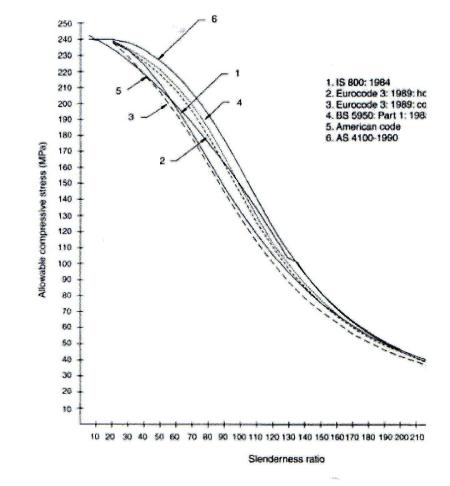 Allowable compressive stress versus selenderness l/r ratio; fy=240
Allowable compressive stress versus selenderness l/r ratio; fy=240from ref 3

Pic 25
Both photos Pic24a & Pic 24b showed the space frame snapped at the ball joint connections. The ball joint connections fixed to the concrete stump were intact.
Questions:-
1. What are the magnitude forces in the members and joints at this point of failure under worst combination of loading acting on the whole roof structure?
2. What were the capacities of the members and connections at this point of failure?
Simillar questions should be asked for the columns and connections along the perimeter that support the roof structures
Since this part of the structures was subjected to cyclic loading the steel members and joints may fail by fatigue. Fatigue considerations are important because the consequent failure is generally sudden and at a stress level much lower than the ultimate stress.
Questions:-
Will the configuration and assemblage of members and joints as shown in fig 25 being able to withstand the worst forces at this location? Definitely it cant because it snapped at this point. Why? What did the assemblage indicated ?
The configuration and assemblage of members and connections as shown in fig 25 were not suitable for any reversal of loads such as wind or dynamic loading.
Shah Alam Stadium
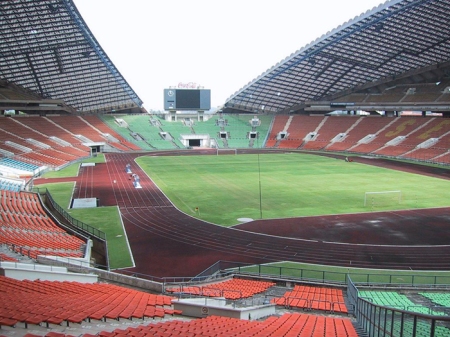
Pic 26
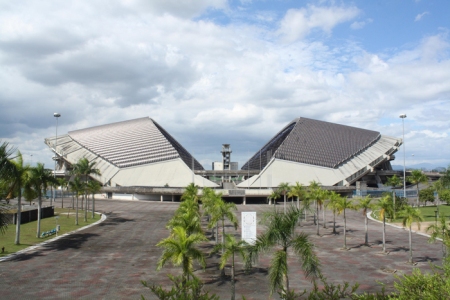
Pic 27
The latticed shell roofs were supported rigidly on all three sides
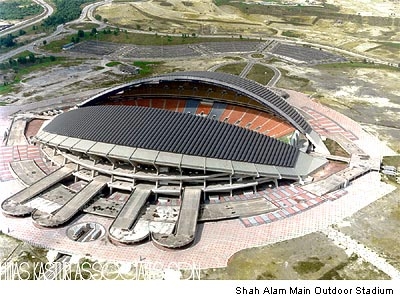
Pic 28
The shape(see the dominating effect of geometry in attached article) and the ends restrains are very important in this egg shell like structures.
Hold an A4 size paper along the shorter edges with you left and right hand respectively. Move your hands a bit towards each other so that the paper form a curves. The distnace between the fingures of the hands is the span of the “thin shell”; It can span thousands of time of its thickness.
Now hold the paper just along one of the longitudinal edge. The paper cant even supports its own weight.
The three edges must be designed to provide the required rigidity(see Shah Alam Stadium(pic 28).
Loads applied to the shell are carried by in general through a combination of bending and stretching(inplane membrane tension or compression of struts) actions, which generally vary from point to point.
For flat roof shell or latticed shells bending was the dominant effect.
